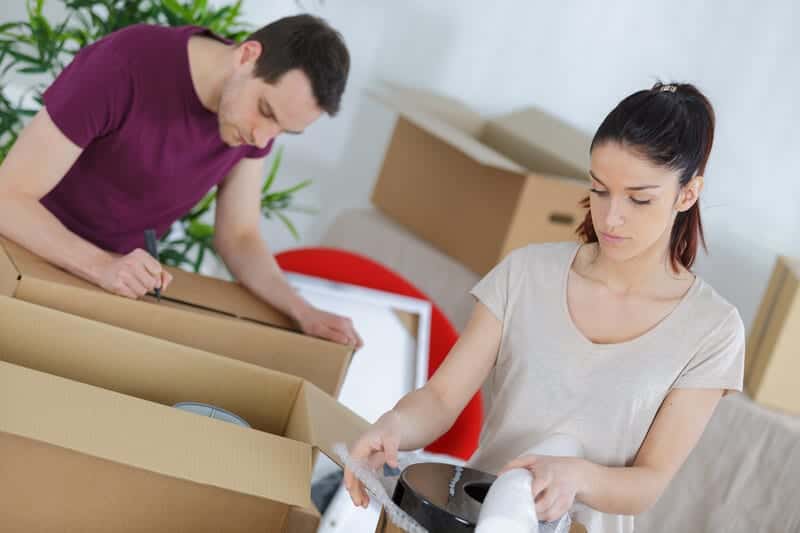Best ways to pack up fragile items
Packing up the more fragile items requires extra thought and more attention to detail to make sure they arrive at their destination without damage. Check out our tried and true tips from Pricing Van Lines to get the TV there crack free:
1. Choose the Right Box
- Don’t cheap out. Use a sturdy, dry cardboard box that is the right size for the items you’re packing.
- It should be large enough to give the item enough room with extra space for padding materials.
- Don’t over shove everything into one box.
2. Wrap Each Item Separately
- Wrap each fragile item individually with many layers of bubble wrap, packing paper, or foam. You can even get creative and use towels, sheets and blankets.
- Pay attention to delicate areas like corners that can easily get damaged while packing
3. Padding Padding Padding!
- Line the bottom of every single box of semi fragile to fragile objects with a thick layer of padding material like packing peanuts (cheap but they make a mess), bubble wrap, or newspaper. Place the wrapped items in the box and fill any empty spaces with more cushioning material to prevent items bouncing around during the transit and breaking.
- This is the make it or break it- literally! Don’t cheap out on the amount of material you use here.
4. Layer Like A Chocolate Cake
- When you start packing up many fragile items in the same box, make sure that you remember to put a layer of padding material between each piece for extra protection.
- Double check that there is enough padding around each item separately to prevent the items from rolling into each other or into the sides of the box. This isi usually the time when items end up broken to pieces.
5. Securely Seal the Box
- Don’t skim on this stage. If your box opens during transit you are likely to both lose and break everything inside. Especially if you are using a shared moving vehicle. Once all fragile items are packed inside your boxes, securely seal the box with tape. Double tape in a X form to ensure it is reinforced.
- As well try to strengthen the seams of the box with extra tape to prevent the box from opening up during transit.
6. Label the Box as Fragile
- Another critical part to our guide seems simple but is not to be overlooked. Clearly label the box as “Fragile” or write “Handle with Care” to give your movers a heads up that this is a box they shouldn’t throw down with all the others. Don;t overuse this on every box or it will be seen as something that can be overlooked.
7. Double Box it for Extra Protection
- For extremely fragile items, extremely heavy pieces or very valuable small pieces, think about double boxing for added protection.
- Place the securely packed box inside a larger box filled with extra padding layers to provide an additional layer of pad against impact.
- Make sure to double the box before packing to make sure the sizing works out.
8. Professional Packing Services Options
- If you’re packing extremely delicate or very valuable items, you may want to consider hiring the pros and using their packing services. Pricing Van Lines can hook you up with the best of the best. They will have the expertise and professional materials to ensure your items are packed safely and securely that you likely lack.
- Consider the price of your items breaking as an opportunity cost to offset the cost of pro packing services.
Other pro tips
- Start early, it will take longer than you actually expect
- Wrapping each glass piece with its ridges and cracks requires more tape than you would imagine- plan ahead.
- Don’t layer too many breakable items like plates together as you are raising the chances that they will break each other from the pressure.
- Ask for help from family and friends once you have a pile of breakables as the task of bubble wrapping many pieces is extremely tedious and time consuming. You may become lax about the job and end up breaking pieces if you are alone on the task.
- Don’t over stuff any box especially with breakables. It will become too heavy and you are likely to break pieces just trying to move the box around.
- Bring extra bubble wrap for all those kitchen breakable pieces.
- Label each and every box clearly to save the headache of unpacking and running pieces between random rooms.
Closing Notes for Your Boxing Ceremony
When you follow these tips and tricks you minimize the risk of damage to your fragile items during the move itself and ensure they arrive at their destination in one piece. It is important to not take lightly the importance of proper packing.
The costs of saving on materials and labor versus the opportunity costs of breaking expensive pieces you will need to repurchase just isn’t worth it. When you are making a long distance move, don’t skimp on packing materials and do it right from the get go.
Frequently Asked Questions
Is a garage sale really profitable and worth my time?
Depending on your advertising methods and items brought in, a garage sale can be a great way to make a few extra hundred bucks! Organizing and managing a garage sale can be very time consuming, so consider this before starting, as donating your unwanted items might be a better fit. The more items you are able to rid yourself of, the less packing materials you will need.
Is tipping my movers important?
Yes, even critical. Your moving team are hard workers helping you get from A to B. Tipping between 15-20% is expected by movers and drivers alike. Think of it as if you’ve gone to a restaurant and left without tipping- not cool. Plan ahead for these costs so you aren’t surprised. Trust us.
Why would using a packing service be helpful?
Professional packers are not a must, but will work at lightspeed to get all your items packed up safely. While you might get stuck sorting through old junk, they will have your entire home packed up and bubble wrapped in no time.
If you are in a time crunch, in the midst of important work projects, or just want to feel like a pro, consider using a packing full service moving option. If you have many expensive and fragile items their service could be a must for you as well.
How long does it actually take to pack up a normal sized bedroom?
It can take anywhere from 5 hours to a few days. The real timing depends on multiple factors such as size, clutter, your focus level, clothing preferences, and other items.
It’s more of a question for yourself if you plan to declutter and go Marie Condo or if you plan to throw everything in a box and call it a day. Plan according to this. Don’t forget to label as you go!
What is a climate controlled storage unit and when would I need one?
If you are moving homes and have a break in between your move in and move out dates, you will need to be able to store your things away for a period of time. If this is the case, you’ll find yourself looking around for the best storage unit for your needs and budget.
Why?
- To keep your things while you set your home up for an open house
- You might not want certain things in the back of the moving truck being jostled around
- You might be going through a big life change and not be in your place of residence for an unknown period of time
- You might be traveling in between jobs
- You might just want somewhere safe to keep certain items for a time




